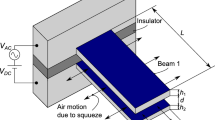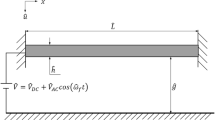Abstract
Several studies have shown that MEMS devices deploying electrically-actuated vibrating beams, such as resonant sensors and RF filters may fail to operate when undergoing mechanical shocks due to the pull-in instability. To this end, we investigate the possibility to overcome or exploit this issue by considering different microsystem designs based on the application of interest. This objective is carried out through developing a nonlinear reduced-order model to simulate the dynamic response of single and dual microbeams under varying electric actuation and shock loads. The actuation of the single-beam system is made via a fixed electrode (uncoupled actuation) while the dual-beam system, composed of two movable microbeams, is actuated by applying a voltage among them (coupled actuation). We use the Galerkin method to discretize the governing equations in space and the Runge–Kutta method to integrate the resulting nonlinear ordinary differential equations. We first perform the static analysis to determine the pull-in voltage. We formulate the coupled eigenvalue problem to compute the natural frequencies of the microsystems under investigation for different applied DC voltages. Then, we introduce the AC excitation and generate the frequency-response curves. Finally, we analyze the impact of the mechanical shock (represented by an impact pulse acceleration) on the microsystems’ dynamic behavior. The present results are in good agreement with those obtained from previously-published theoretical and experimental studies. We observe a significant reduction in the static pull-in voltage and switching time when considering the dual-beam system in comparison with the single-beam case. The frequency-response curves show expanded dynamic pull-in bandwidth when operating the dual-beam system near the primary resonance. We notice that the dual-beam systems are more robust in terms of resistance to mechanical shock. This shows the suitability of such design for the operation and reliability of MEMS devices in harsh environments characterized by high mechanical shock levels. On the other hand, single-beam systems seem to be more attractive for use as microswitches which are intended to trigger a signal once receiving a mechanical shock or abrupt change in acceleration to activate safety functionalities, such as airbag systems.













Similar content being viewed by others
References
Akbari HR, Ceballes S, Abdelkefi A (2017) Geometrical influence of a deposited particle on the performance of bridged carbon nanotube-based mass detectors. Phys E 94:31–46
Askari AR, Tahani M (2014) An alternative reduced order model for electrically actuated micro-beams under mechanical shock. Mech Res Commun 57:34–39
Bouchaala A (2018) Size effect of a uniformly distributed added mass on a nanoelectromechanical resonator. Microsyst Technol 24(6):2765–2774
Bouchaala A, Jaber N, Yassine O, Shekhah O, Chernikova V, Eddaoudi M, Younis MI (2016a) A smart microelectromechanical sensor and switch triggered by gas. Appl Phys Lett 109:013502
Bouchaala A, Jaber N, Yassine O, Shekhah O, Chernikova V, Eddaoudi M, Younis MI (2016b) Nonlinear-based MEMS sensors and active switches for gas detection. Sensors 16:758
Bouchaala A, Nayfeh AH, Jaber N, Younis M (2016c) Mass and position determination in MEMS mass sensors: a theoretical and an experimental investigation. J Micromech Microeng 26:1–10
Brown TG, Davis B, Hepner D, Faust J, Myers C, Muller P, Harkins T, Hollis M, Miller C, Placzankis B (2001) Strap-down microelectromechanical (MEMS) sensors for high-g munition applications. IEEE Trans Magn 37:336–342
Dai H, Wang L (2015) Surface effect on the pull-in instability of cantilevered nano-switches based on a full nonlinear model. Phys E 73:141147
Ghommem M, Abdelkefi A (2017a) Nonlinear analysis of rotating nanocrystalline silicon microbeams for microgyroscope applications. Microsyst Technol 23:59315946
Ghommem M, Abdelkefi A (2017b) Novel design of microgyroscopes employing electrostatic actuation and resistance-change based sensing. J Sound Vib 411:278–288
Ghommem M, Nayfeh A, Choura S, Najar F, Abdel-Rahman E (2010) Modeling and performance study of a beam microgyroscope. J Sound Vib 329:4970–4979
Ghommem M, Nayfeh A, Choura S (2013) Model reduction and analysis of a vibrating beam microgyroscope. J Vib Control 19:1240–1249
Ibrahim M, Younis MI (2009) The dynamic response of electrostatically driven resonators under mechanical shock. J Micromech Microeng 20:025006
Ilyas S, Chappanda MAA-HKN, Ramini A, Younis M (2016) An experimental and theoretical investigation of electrostatically-coupled cantilever microbeams. Sens Actuators A Phys 247:368–378
Jrad M, Younis MI, Najar F (2016) Modeling and design of an electrically actuated resonant microswitch. J Vib Control 22:559569
Li H, Guo C, Li Y, Chen Y, Liu J, Chen Z (2016) Deformation characteristics of MEMS microspring under static and shock loads. Microsyst Technol 22:29492960
Mo Y, Du L, Qu B, Peng B, Yang J (2014) Squeeze film air damping ratio analysis of a silicon capacitive micromechanical accelerometer. Microsyst Technol 24:10891095
Nayfeh AH, Ouakad HM, Najar F, Choura S, Abdel-Rahman EM (2010) Nonlinear dynamics of a resonant gas sensor. Nonlinear Dyn 59:607618
Ouakad H (2015) The response of a micro-electro-mechanical system (MEMS) cantilever-paddle gas sensor to mechanical shock loads. J Vib Control 21:2739–2754
Ouakad HM (2018) Electrostatic fringing-fields effects on the structural behavior of MEMS shallow arches. Microsyst Technol 24:13911399
Ouakad H, Younis M (2014) On using the dynamic snap-through motion of MEMS initially curved microbeams for filtering applications. J Sound Vib 2:555–568
Parkos D, Raghunathan N, Venkattraman A, Sanborn B, Chen W, Peroulis D (2013) Near-contact gas damping and dynamic response of high-g MEMS accelerometer beams. J Microelectromech Syst 22:1089–1099
Raghunathan N, Fruehling ENA, Cheny W, Peroulis D (2010) Arrays of silicon cantilevers for detecting high-g rapidly varying acceleration profiles. In: IEEE sensors 2010 conference, pp 1203–1206
Ramini A, Younis MI, Su QT (2013) Low-g electrostatically actuated resonant switch. Smart Mater Struct 22:025006
Samaali H, Najar F (2017) Design of a capacitive MEMS double beam switch using dynamic pull-in actuation at very low voltage. Microsyst Technol 23:53175327
Samaali H, Najar F, Choura S, Nayfeh AH, Masmoudi M (2011) A double microbeam MEMS ohmic switch for RF-applications with low actuation voltage. Nonlinear Dyn 63:719–734
Samaali H, Najar F, Choura S (2014) Dynamic study of a capacitive MEMS switch with double clamped-clamped microbeams. Shock Vib 2014:807489
Siavash P, Ayazi F (2005) Electrically coupled MEMS bandpass filters: part II. Without coupling element. Sens Actuators A Phys 122:317–325
Srikar VT, Senturia SD (2002) The reliability of microelectromechanical systems (MEMS) in shock environments. J Microelectromech Syst 11:206–214
Sundaram S, Tormen M, Timotijevic B, Lockhart R, Overstolz T, Stanley RP, Shea HR (2011) Vibration and shock reliability of MEMS: modeling and experimental validation. J Micromech Microeng 21:045022
Wagner U, Frank J, Schweiker M, Bernhard W, Muller-Fiedler R, Michel B, Paul O (2001) Mechanical reliability of MEMS-structures under shock load. Microelectron Reliab 41:1657–1662
Younis MI (2011) MEMS linear and nonlinear statics and dynamics. Springer, New York
Younis M, Alsaleem F (2009) Exploration of new concepts for mass detection in electrostatically-actuated structures based on nonlinear phenomena. J Comput Nonlinear Dyn 4:033108
Younis M, Miles R, Jordy D (2006) Investigation of the response of microstructures under the combined effect of mechanical shock and electrostatic forces. J Micromech Microeng 16:2463–2474
Younis MI, Alsaleem FM, Miles R, Su Q (2007) Characterization for the performance of capacitive switches activated by mechanical shock. J Micromech Microeng 17:1360–1370
Zhou J, Jiang T, Jiao J, Wu M (2014) Design and fabrication of a micromachined gyroscope with high shock resistance. Microsyst Technol 20:137144
Author information
Authors and Affiliations
Corresponding author
Additional information
Publisher's Note
Springer Nature remains neutral with regard to jurisdictional claims in published maps and institutional affiliations.
Appendix
Appendix
The schematic representation of the microsystem under investigation is shown in Fig. 1. The parameters \(l_i\), \(b_i\), \(h_i\), \(I_i\), and \(\rho\) denote the length, width, thickness, the second area moment of the cross section, and the mass density of the microbeam. The subscript i refers to microbeam i. E is the Young’s modulus. The microbeams are electrically-actuated and subjected to mechanical shock. The displacements of the microbeams are represented by \(w_i\). We express the kinetic energy of the dual beam microsystem as
The potential energy is given by
Here, the prime and the dot denote the spatial and time derivatives, respectively. The variation of the works done by the electric excitation, the mechanical shock (represented by an impact acceleration pulse of a half-sine waveform), and the linear damping are expressed as
Substituting Eqs. (32)–(34) into the generalized Hamilton’s principle given by
leads to the nonlinear coupled equations of motion of the dual beam microsystem given by Eqs. (3) and (4).
Rights and permissions
About this article
Cite this article
Ahmed, M.S., Ghommem, M. & Abdelkefi, A. Nonlinear analysis and characteristics of electrically-coupled microbeams under mechanical shock. Microsyst Technol 25, 829–843 (2019). https://doi.org/10.1007/s00542-018-4056-2
Received:
Accepted:
Published:
Issue Date:
DOI: https://doi.org/10.1007/s00542-018-4056-2




